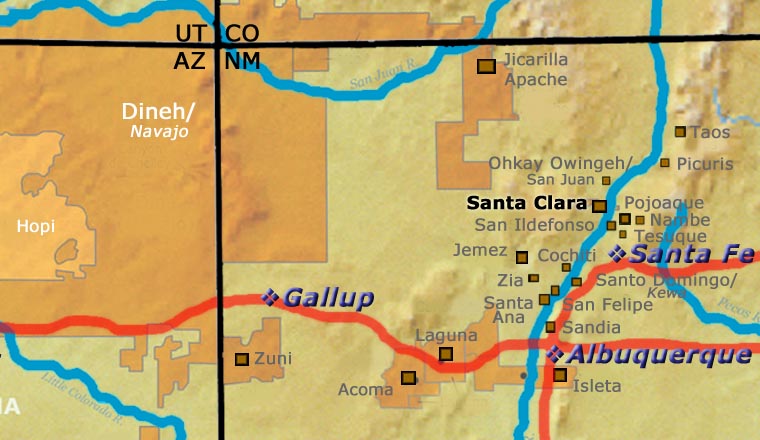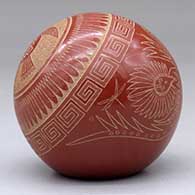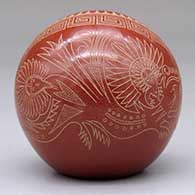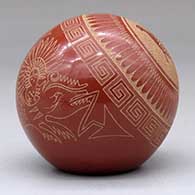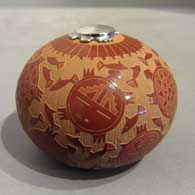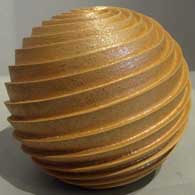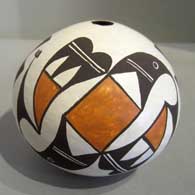
Joseph Lonewolf
1932-2014
Santa Clara
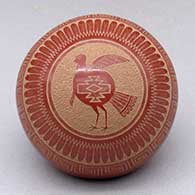
Joseph Lonewolf was born into Santa Clara Pueblo in January of 1932. Both his parents, Camilio Sunflower Tafoya and Agapita Silva were well established potters. Joseph's mother taught him to work with clay at an early age, then his father taught him to sculpt the clay. From his earliest years he made miniature incised pots and gave them to his friends and family.
Joseph spent a number of years working as a mechanic and precision machinist in Colorado before returning to Santa Clara and dedicating himself to becoming a master potter in 1971. He was encouraged by his sister, Grace Medicine Flower, and worked some with his father at first before producing exquisite, finely incised miniature pots. His pottery was soon referred to as "pottery jewels," owing to their very delicate cameo-like appearance. A book was published in 1974 entitled "The Pottery Jewels of Joseph Lonewolf," one of the first books ever highlighting a single Native American artist.
Joseph has also been credited as the innovator of two-tone pottery (red and black) using a single-fire process. Previous methods of producing two-tone pottery required two firings. Joseph also pioneered the use of different colored slips on his pottery, often using red, yellow, orange, green, sienna, purple, black, brown and buff slips he discovered in the soils of Colorado. His wife Kathy once said that when Joseph was riding in the car (she always drove) that he could not only tell what color the passing dirt could produce but he could do it at 30 miles per hour. He always made his pots using the traditional Santa Clara techniques of hand-coiling and ground-firing.
Joseph's designs were all one of a kind, incorporating elements of nature, ancient Mimbres designs and contemporary Santa Clara styles. After firing, he inspected all his pots carefully before adding his name, his wolf's head hallmark, and a number and date to the bottom of each. Anything that didn't pass that inspection was immediately destroyed. Joseph always had dozens of pieces in various states of completion. After his passing his studio shelves were lined with these pots. Just recently his daughter Rosemary, a skilled potter in her own right, decided that she may take on the responsibility of finishing some of his pieces.
In 1976 Joseph, his father Camilio, his sister Grace and his daughter Rosemary were featured in a show at Tanner's Indian Arts Gallery in Scottsdale, AZ. Also in attendance for that show was Rosemary's husband, painter Paul Speckled Rock, and Joseph's other daughter Susan with her husband, painter Mike Romero. Back in Santa Fe, the Wheelwright Museum of the American Indian recognized Joseph's work with an exhibition in 1977. Other gallery shows in Vail, Colorado Springs and Las Vegas followed quickly. In 1981 Joseph's pottery was featured in major exhibits in three other major museums: the Native American Center for Living Arts in Niagara Falls, NY, the Eiteljorg Museum of American Indians and Western Art in Indianapolis, IN, and the Heard Museum in Phoenix, AZ. 1984 saw Joseph and his father Camilio doing a show at the Indian Jewelry Center in Sacramento, CA. In 1985 it was a show at the Sid Deusch Gallery in New York and in 1986 it was a show at McGee's Indian Den in Scottsdale again.
In 1994 Joseph participated in a show at the Four Winds Gallery in Pittsburgh, PA, along with Michael Naranjo, Roxanne Swentzel and Mike Bird. Later that year he enjoyed a solo gallery show at Andrea Fisher Fine Pottery in Santa Fe. In 1996 Joseph returned to the Four Winds Gallery in Pittsburgh with Virgil Ortiz, Roxanne Swentzell, Mike Bird and others. King Galleries of Scottsdale had a show featuring Joseph and his sister Grace Medicine Flower in 1998. That same year pieces made by Joseph and Grace were part of the "Harris Collection" show at the Blue Rain Gallery in Santa Fe, NM, along with pottery made by Tammy Garcia, his aunt Margaret Tafoya, his father Camilio Tafoya, Maria and Julian Martinez, Popovi Da, Tony Da, Teresita Naranjo and others.
Joseph taught his methods and techniques to his three children, Susan Snowflake Romero (Lonewolf), Rosemary Apple Blossom Lonewolf and Greg Lonewolf, before he passed on in 2014.
Some Exhibits that Featured Pieces by Joseph
- Choices and Change: American Indian Artists in the Southwest. Heard Museum North. Scottsdale, Arizona. June 30, 2007-2013
- Crafted to Perfection: The Nancy & Alan Cameron Collection of Southwestern Pottery. Rockwell Museum of Western Art. Corning, New York. November 22, 2007 - May 18, 2008
- Home: Native People in the Southwest. Heard Museum. Phoenix, Arizona. May 1 - September 2005
- The Collecting Passions of Dennis and Janis Lyon. Heard Museum. Phoenix, Arizona. May 1 - September 2004
- Every Picture Tells a Story. Heard Museum. Phoenix, Arizona. September 20, 2002 - 2005
- Hold Everything! Masterworks of Basketry and Pottery from the Heard Museum. Heard Museum. Phoenix, Arizona. November 1, 2001 - March 10, 2002
- Sharing the Heritage: American Indian Art from Oklahoma Private Collections. Fred Jones Jr. Museum of Art. University of Oklahoma. Norman, Oklahoma. June 9 - September 11, 1994
- The Seven Families of Pueblo Pottery. Simply Santa Fe. Santa Fe, New Mexico. August 16 - 30, 1990
- Celebrating the Spirit: Contemporary Native American Art. Felicita Foundation for the Arts. Mathes Cultural Center. Escondido, California. October 21 - November 30, 1985
- American Indian Art in the 1980s. The Native American Center for the Living Arts. Niagara Falls, New York. 1981
- Joseph Lonewolf, Camilio Sunflower Tafoya, Pho-Sa-We; Presenting a New Collection of Their Incomparable Pottery Creations. Galeria Capistrano. San Juan Capistrano, California. September 26-28, 1980
- Joseph Lonewolf, Grace Medicine Flower. Adobe Galleries. Las Vegas, Nevada. March 24-26, 1977
- The Joseph Lonewolf Family Show. Tanner's Indian Arts. Scottsdale, Arizona. November 20 - 23, 1975
- 1975 Scottsdale National Indian Arts Exhibition. Safari Hotel Convention Center. Scottsdale, Arizona. March 12-15, 1975
- Tony Begay Memorial Show. Heard Museum. Phoenix, Arizona. February 2-17, 1974. Note: exhibition and auction to benefit the children of Tony Begay; includes artwork by Tony Begay and many of his Indian artist friends
- 1972 Scottsdale National Indian Arts Exhibition. Safari Hotel Convention Center. Scottsdale, Arizona. March 29 - April 2, 1972
- 1970 Scottsdale National Indian Arts Exhibition. Executive House. Scottsdale, Arizona. February 28 - March 8, 1970
Some Awards Earned by Joseph
- 1989 Gallup InterTribal Ceremonial. Best of Category Pottery, Contemporary Miniature
- 1987 Gallup InterTribal Ceremonial. Classification IV - Contemporary, any object: Second Place
- 1975 Scottsdale National Indian Arts Exhibition. Section C - Crafts, Classification VIII - Pottery, Division B - Adaptions: First Place
- 1972 Scottsdale National Indian Arts Exhibition. Section C - Crafts, Classification VIII - Pottery, Division B - Adaptions: First Place
- 1970 Scottsdale National Indian Arts Exhibition. Section B - Crafts, Classification VIII - Pottery, Division B - Adaptions: Honorable Mention
100 West San Francisco Street, Santa Fe, New Mexico 87501
(505) 986-1234 - www.andreafisherpottery.com - All Rights Reserved

Santa Clara Pueblo
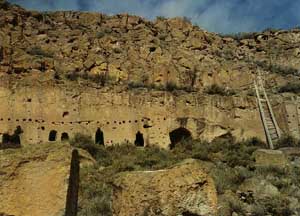
Ruins at Puye Cliffs, Santa Clara Pueblo
Santa Clara Pueblo straddles the Rio Grande about 25 miles north of Santa Fe. Of all the pueblos, Santa Clara has the largest number of potters.
The ancestral roots of the Santa Clara people have been traced to ancient pueblos in the Mesa Verde region in southwestern Colorado. When that area began to get dry between about 1100 and 1300 CE, some of the people migrated eastward, then south into the Chama River Valley where they constructed several pueblos over the years. One was Poshuouinge, built about 3 miles south of what is now Abiquiu on the edge of the Jemez foothills above the Chama River. Eventually reaching two and three stories high, and with up to 700 rooms on the ground floor, Poshuouinge was occupied from about 1375 CE to about 1475. Drought then again forced the people to move, some of them going to the area of Puye (on the eastern slopes of the Pajarito Plateau of the Jemez Mountains) and others downstream to Ohkay Owingeh (San Juan Pueblo, along the Rio Grande). Beginning around 1580 CE, drought forced the residents of the Puye area to relocate closer to the Rio Grande and they founded what we now know as Santa Clara Pueblo on the west bank of the river, with San Juan Pueblo to the north and San Ildefonso Pueblo to the south.
In 1598 the seat of Spanish government was established at Yunque, near San Juan Pueblo. The Spanish proceeded to antagonize the Puebloans so badly that that government was moved to Santa Fe in 1610, for their own safety.
Spanish colonists brought the first missionaries to Santa Clara in 1598. Among the many things they forced on the people, those missionaries forced the construction of the first mission church around 1622. However, like the other pueblos, the Santa Clarans chafed under the weight of Spanish rule. As a result, they were in the forefront of the Pueblo Revolt of 1680. One Santa Clara resident, a mixed black and Tewa man named Domingo Naranjo, was one of the rebellion's ringleaders. However, the pueblo unity that allowed them to chase the Spanish out fell apart shortly after their success, especially after Popé died.
When Don Diego de Vargas came back to the area in 1694, he found most of the Santa Clarans on top of nearby Black Mesa (with the people of San Ildefonso). A six-month siege didn't subdue them so finally, the two sides negotiated a treaty and the people returned to their pueblos. However, successive invasions and occupations by northern Europeans took their toll on all the tribes over the next 250 years. Then the swine flu pandemic in 1918 almost wiped them out.
Today, Santa Clara Pueblo is home to as many as 2,600 people and they comprise probably the largest per capita number of artists of any North American tribe (estimates of the number of potters run as high as 1-in-4 residents).
Today's pottery from Santa Clara is typically either black or red. It is usually highly polished and designs might be deeply carved or etched ("sgraffito") into the pot's surface. The water serpent, (avanyu), is a very common traditional design motif on Santa Clara pottery. Another motif comes from the legend that a bear helped the people find water during a drought. The bear paw has appeared on much of their pottery ever since.
Santa Clara has received a lot of distinction because of the evolving artistry the potters have brought to their craft. Not only did this pueblo produce excellent black and redware, several notable innovations helped move pottery from the realm of utilitarian vessels into the domain of art. Different styles of polychrome redware emerged in the 1920s-1930s. In the early 1960s experiments with stone inlay, incising and double firing began. Modern potters have also extended the tradition with unusual shapes, slips and designs, illustrating what one Santa Clara potter said: "At Santa Clara, being non-traditional is the tradition." (This refers strictly to artistic expression; the method of creating pottery remains traditional).
Santa Clara Pueblo is home to a number of famous pottery families: Tafoya, Baca, Gutierrez, Naranjo, Suazo, Chavarria, Garcia, Vigil, and Tapia - to name a few.
100 West San Francisco Street, Santa Fe, New Mexico 87501
(505) 986-1234 - www.andreafisherpottery.com - All Rights Reserved

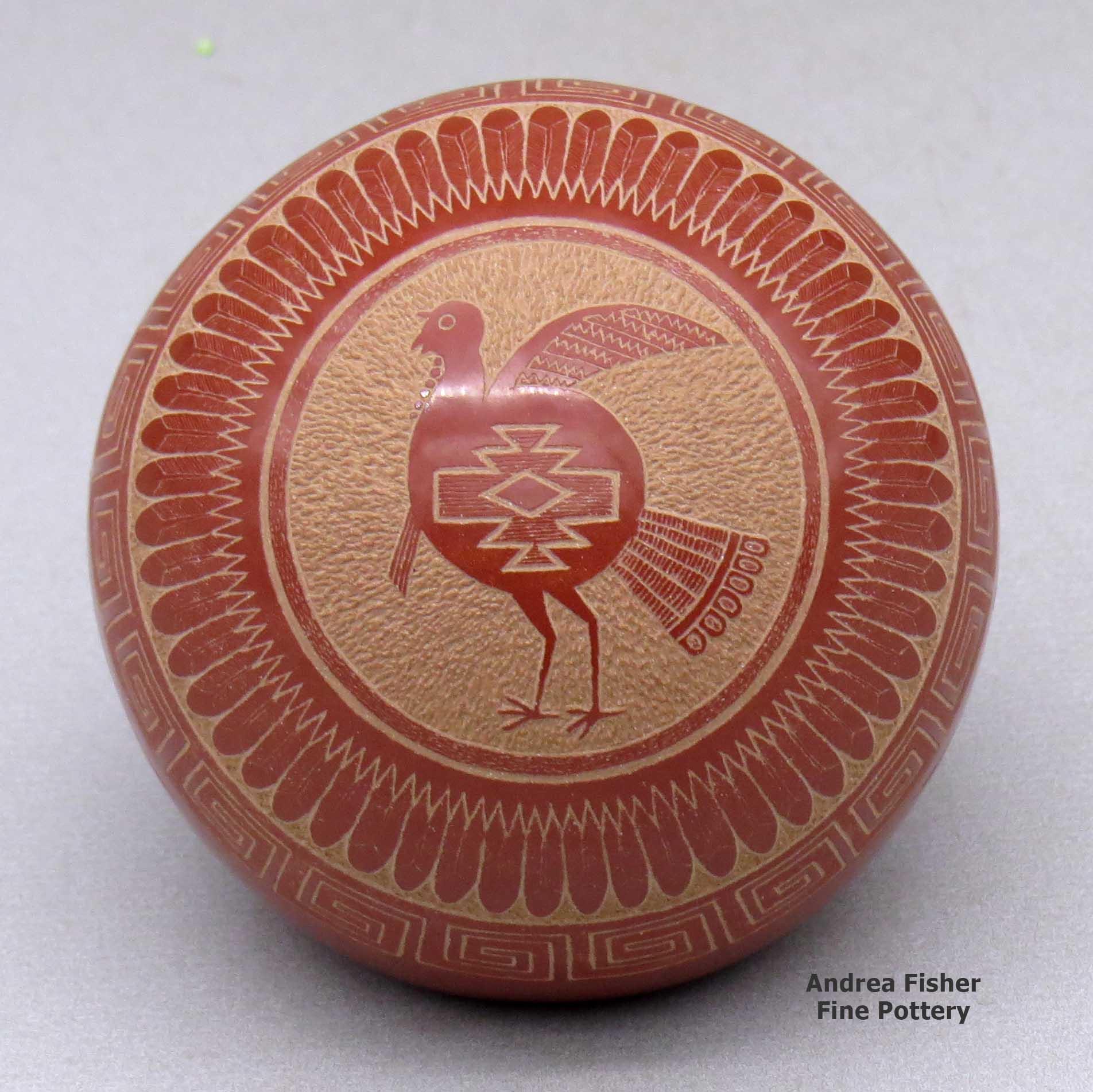
Joseph Lonewolf, Santa_Clara, Aminiatureredseedpotdecoratedwithaasgraffitoturkey,feather,scroll,avanyu,katsinaandgeometricdesign
Santa Clara
$ 3500
zzsc4f409
A miniature red seed pot decorated with a a sgraffito turkey, feather, scroll, avanyu, katsina and geometric design
2.5 in L by 2.5 in W by 2.5 in H
Condition: Excellent
Signature: Joseph Lonewolf 017E9M with his wolf head hallmark
Date Created: 1979
100 West San Francisco Street, Santa Fe, New Mexico 87501
(505) 986-1234 - www.andreafisherpottery.com - All Rights Reserved

Seed Pots
Acoma, Hopi, Isleta, Jemez, Laguna, San Felipe, San Ildefonso, San Juan, Santa Clara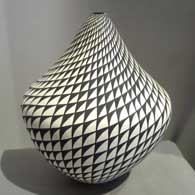
Acoma Pueblo
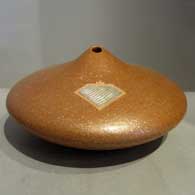
Hopi
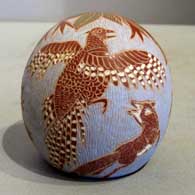
Santa Clara Pueblo
It was a matter of survival to the ancient Native American people that seeds be stored properly until the next planting season. Small, hollow pots were made to ensure that the precious seeds would be kept safe from moisture, light and rodents. After seeds were put into the pot, the small hole in the pot was plugged. The following spring the plug was removed and the seeds were shaken from the pot directly onto the planting area.
Today, seed pots are no longer necessary due to readily available seeds from commercial suppliers. However, seed pots continue to be made as beautiful, decorative works of art. The sizes and shapes of seed pots have evolved and vary greatly, depending on the vision of Clay Mother as seen through the artist. The decorations vary, too, from simple white seed pots with raised relief to multi-colored painted, raised relief and sgraffito designs, sometimes with inlaid gemstones and silver lids.
100 West San Francisco Street, Santa Fe, New Mexico 87501
(505) 986-1234 - www.andreafisherpottery.com - All Rights Reserved

Miniatures
Most people think that miniature pottery is something new in the world of Native American pottery. In reality, archaeologists have found miniature pottery in the remains of ancient ruins in Chaco Canyon, Mesa Verde, across eastern Arizona, southern New Mexico and south to the Paquimé and Casas Grandes region in northern Mexico. Archaeologists working in the eastern US have found miniature pottery spread across Early Woodland Culture sites, too, dated up to 1700 years ago.
We have no idea as to why the ancients created miniature pottery but there's lots of speculation. Perhaps it was made as toys for children. Perhaps it was made by children learning to make pottery, and as their expertise grew, the size of their pieces grew, too. Perhaps it was made and placed in a firing pit as a good luck charm, hoping that other pots being fired in the pit would survive the firing process and not crack or break. Perhaps it was made for some ceremonial purpose we have no possibility of knowing. We do know that in North America, almost every pottery-making group of ancients made miniature pottery. They decorated it, too, just like the full size pottery the women of the time were making.
As the rebirth of traditionally made Native American pottery has unfolded over the last century, research into the ancient forms, styles and designs has also brought the miniature back into focus. There are more than a few potters these days making tiny gems again, similar to and, at the same time, more refined than the products of the potters of prehistory. And while some are still being made by children learning as they grow up, many more are being made by established adult potters. Some have made their entire careers around the making of miniatures while others sometimes make a few miniatures to complement the full range of forms and styles of full size pieces they make.
100 West San Francisco Street, Santa Fe, New Mexico 87501
(505) 986-1234 - www.andreafisherpottery.com - All Rights Reserved

Margaret Tafoya Family Tree
Disclaimer: This "family tree" is a best effort on our part to determine who the potters are in this family and arrange them in a generational order. The general information available is questionable so we have tried to show each of these diagrams to living members of each family to get their input and approval, too. This diagram is subject to change should we get better info.
Note: Sarafina (Gutierrez) Tafoya was the sister of Pasqualita Tani Gutierrez.
- Sarafina Tafoya (1863-1949) & Geronimo Tafoya
- Margaret Tafoya (1904-2001) & Alcario Tafoya (d. 1995)
- Mary Ester Archuleta (1942-2010)
- Barry Archuleta
- Bryon Archuleta
- Sheila Archuleta
- Jennie Trammel (1929-2010)
- Karen Trammel Beloris
- Virginia Ebelacker (1925-2001)
- James Ebelacker (1960-) & Cynthia Ebelacker
- Jamelyn Ebelacker
- Sarena Ebelacker
- Richard Ebelacker (1946-2010) & Yvonne Ortiz
- Jason Ebelacker
- Jerome Ebelacker & Dyan Esquibel
- Andrew Ebelacker
- Nickolas Ebelacker
- James Ebelacker (1960-) & Cynthia Ebelacker
- Lee Tafoya (1926-1996) & Betty Tafoya (Anglo)
- Linda Tafoya (Oyenque)(Sanchez) (1962-)
- Antonio Jose Oyenque
- Jeremy Rio Oyenque
- Maria Theresa Oyenque
- Melvin Tafoya
- Phyllis Bustos Tafoya
- Linda Tafoya (Oyenque)(Sanchez) (1962-)
- Mela Youngblood (1931-1990) & Walt Youngblood
- Nancy Youngblood (1955-)
- Christopher Cutler
- Joseph Lugo
- Sergio Lugo
- Nathan Youngblood (1954-)
- Nancy Youngblood (1955-)
- Toni Roller (1935-)
- Brandon Roller
- Cliff Roller (1961-)
- Deborah Morning Star Roller
- Jeff Roller (1963-)
- Jordan Roller
- Ryan Roller
- Susan Roller Whittington (1955-)
- Charles Lewis
- Tim Roller (1959-) & Clarissa Tafoya
- William Roller
- LuAnn Tafoya (1938-) & Sostence Tapia
- Michele Tapia Browning (1960-2025)
- Ashley Browning
- Mindy Browning
- Daryl Duane Whitegeese (1964-) & Rosemary Hardy
- Samantha Whitegeese
- Tina Whitegeese
- Michele Tapia Browning (1960-2025)
- Shirley Cactus Blossom Tafoya (1947-)
- Meldon Tafoya
- Andrea Tafoya
- Crystal Tafoya
- Melissa Tafoya
- Mary Ester Archuleta (1942-2010)
- Christina Naranjo (1891-1980) & Jose Victor Naranjo (1895-1942)
- Mary Cain (1916-2010)
- Billy Cain (1950-2005)
- Joy Cain (1947-)
- Linda Cain (1949-)
- Autumn Borts-Medlock (1967-)
- Tammy Garcia (1969-)
- Douglas Tafoya
- Marjorie Tafoya Tanin
- Teresita Naranjo (1919-1999)
- Stella Chavarria (1939-)
- Denise Chavarria (1959-)
- Joey Chavarria (1964-1987)
- Sunday Chavarria (1963-)
- Stella Chavarria (1939-)
- Cecilia Naranjo
- Sharon Naranjo Garcia (1951-)
- Judy Tafoya (1962-) & Lincoln Tafoya (1954-)
- Mida Tafoya (1931-2024)
- Sherry Tafoya (1956-)
- Phyllis Tafoya (1955-)
- Robert Tafoya
- Ethel Vigil
- Kimberly Garcia
- Mary Cain (1916-2010)
- Camilio Tafoya (1902-1995) & Agapita Silva (1904-1959)
- Joe Tafoya & Lucy Year Flower (1935-2012)
- Kelli Little Kachina (1967-2014)
- Myra Little Snow (1962-)
- Forrest Red Cloud Tafoya
- Shawn Tafoya (1968-)
- Joseph Lonewolf (1932-2014) & Katheryn Lonewolf
- Greg Lonewolf (1952-)
- Rosemary Apple Blossom Lonewolf (1954-) & Paul Speckled Rock (1952-2017)
- Adam Speckled Rock
- Susan Romero
- Grace Medicine Flower (1938-)
- Joe Tafoya & Lucy Year Flower (1935-2012)
- Dolorita Padilla (1897-1960) & Alberto Padilla (1898-)
- Tomacita Tafoya Naranjo (1884-1918) & Agapita Naranjo
- Nicolasa Naranjo (c.1910-) & Jose G. Tafoya
- Howard Naranjo & Linda Naranjo
- Nicolasa Naranjo (c.1910-) & Jose G. Tafoya
Some of the above info is drawn from Pueblo Indian Pottery, 750 Artist Biographies, by Gregory Schaaf, © 2000, Center for Indigenous Arts & Studies
Other info is derived from personal contacts with family members and through interminable searches of the Internet.
(505) 986-1234 - www.andreafisherpottery.com - All Rights Reserved


